Nutrient Load Mitigation with Wintertime Cover as Estimated by the INCA Model
Abstract
:1. Introduction
2. Materials and Methods
2.1. Study Area
2.2. Data Available
2.2.1. Catchment-Scale Data
2.2.2. Field Scale Data
2.3. Models and Model Set-Ups
2.3.1. RUSLE
2.3.2. PERSiST
2.3.3. INCA-N and INCA-P
2.3.4. PEST
2.4. Model Set-Up
2.5. Scenarios
- Autumn ploughing as the primary tillage for all spring cereal fields in the Yläneenjoki catchment;
- Primary tillage as actually performed in the catchment in 1994–1995;
- Primary tillage as actually performed in the catchment in 2008–2010.
3. Results
3.1. Calibration and Uncertainty Bounds
3.2. Plot and Field Measurements
3.3. Parameter Sensitivity
3.4. Scenario Results
4. Discussion
4.1. Model Development
4.2. Nutrient Load Mitigation by Winter Cover
5. Conclusions
Author Contributions
Funding
Institutional Review Board Statement
Informed Consent Statement
Data Availability Statement
Conflicts of Interest
References
- Pietiläinen, O.-P.; Rekolainen, S. Dissolved reactive and total phosphorus load from agricultural and forested basins to surface waters in Finland. Aqua Fenn. 1991, 21, 127–136. [Google Scholar]
- Pietiläinen, O.-P.; Ekholm, P. Origin of eroded material in a small agricultural drainage basin in southwestern Finland. Aqua Fenn. 1992, 22, 105–110. [Google Scholar]
- Uusitalo, R.; Aura, E. A rainfall simulation study on the relationships between soil test P versus dissolved and potentially bioavailable particulate phosphorus forms in runoff. Agric. Food Sci. 2005, 14, 335–345. [Google Scholar] [CrossRef] [Green Version]
- Sharpley, A.N. Soil phosphorus dynamics: Agronomic and environmental impacts. Ecol. Eng. 1995, 5, 261–279. [Google Scholar] [CrossRef]
- Sharpley, A.N.; Rekolainen, S.; Tunney, H. Phosphorus in Agriculture and Its Environmental Implications, in Phosphorus Loss from Soil to Water; Tunney, H., Carton, O.T., Brookes, P.C., Johnston, A.E., Eds.; CAB International Press: Cambridge, UK, 1997; pp. 1–54. [Google Scholar]
- Tamminen, T.; Andersen, T. Seasonal phytoplankton nutrient limitation patterns as revealed by bioassays over Baltic Sea gradients of salinity and eutrophication. Mar. Ecol. Prog. Ser. 2007, 340, 121–138. [Google Scholar] [CrossRef] [Green Version]
- Pietiläinen, O.-P.; Räike, A. Typpi ja Fosfori Suomen Sisävesien Minimiravinteena. In Suomen Ympäristö, Ympäristönsuojelu; Finnish Environment Institute: Helsinki, Finland, 1999; Volume 313, 64p. [Google Scholar]
- Aakkula, J.; Kuussaari, M.; Rankinen, K.; Ekholm, P.; Heliölä, J.; Hyvönen, T.; Kitti, T.; Salo, T. Follow-Up Study on the Impacts of Agri-Environmental Measures in Finland. In Evaluation of Agri-Environmental Policies Selected Methodological Issues and Case Studies; OECD Publishing: Paris, France, 2012; pp. 111–127. [Google Scholar]
- Hyvönen, T.; Heliölä, J.; Koikkalainen, K.; Kuussaari, M.; Lemola, R.; Miettinen, A.; Rankinen, K.; Regina, K.; Turtola, E. Maatalouden Ympäristötoimenpiteiden Ympäristö- ja Kustannustehokkuus (MYTTEHO): Loppuraportti. In Luonnonvara- ja Biotalouden Tutkimus 12/2020; Luonnonvarakeskus: Helsinki, Finland, 2020. [Google Scholar]
- Puustinen, M.; Koskiaho, J.; Peltonen, K. Influence of cultivation methods on suspended solids and phosphorus concen-trations in surface runoff on clayey sloped fields in boreal climate. Agric. Ecosyst. Environ. 2005, 105, 565–579. [Google Scholar] [CrossRef]
- Uusitalo, R.; Lemola, R.; Turtola, E. Surface and Subsurface Phosphorus Discharge from a Clay Soil in a Nine-Year Study Comparing No-Till and Plowing. J. Environ. Qual. 2018, 47, 1478–1486. [Google Scholar] [CrossRef] [Green Version]
- Puustinen, M.; Turtola, E.; Kukkonen, M.; Koskiaho, J.; Linjama, J.; Niinioja, R.; Tattari, S. VIHMA—A tool for allocation of measures to control erosion and nutrient loading from Finnish agricultural catchments. Agric. Ecosyst. Environ. 2010, 138, 306–317. [Google Scholar] [CrossRef]
- Muukkonen, P.; Hartikainen, H.; Lahti, K.; Särkelä, A.; Puustinen, M.; Alakukku, L. Influence of no-tillage on the distribution and lability of phosphorus in Finnish clay soils. Agric. Ecosyst. Environ. 2007, 120, 299–306. [Google Scholar] [CrossRef]
- Ulen, B.; Aronsson, H.; Bechmann, M.; Krogstad, T.; Oygarden, L.; Stenberg, M. Soil tillage methods to control phosphorus loss and potential side-effects: A Scandinavian review. Soil Use Manag. 2010, 26, 94–107. [Google Scholar] [CrossRef]
- Uusi-Kämppä, J.; Jauhiainen, L. Long-term monitoring of buffer zone efficiency under different cultivation techniques in boreal conditions. Agric. Ecosyst. Environ. 2010, 137, 75–85. [Google Scholar] [CrossRef]
- Uusitalo, R.; Turtola, E.; Lemola, R. Phosphorus losses from a subdrained clayey soil as affected by cultivation practices. Agric. Food Sci. 2007, 16, 352–365. [Google Scholar] [CrossRef] [Green Version]
- Baker, D.B.; Johnson, L.T.; Confesor, R.B.; Crumrine, J.P. Vertical Stratification of Soil Phosphorus as a Concern for Dissolved Phosphorus Runoff in the Lake Erie Basin. J. Environ. Qual. 2017, 16, 1287–1295. [Google Scholar] [CrossRef] [Green Version]
- Thompson, C.A.; Whitney, D.A. Effects of 30 years of cropping and tillage systems on surface soil test changes. Commun. Soil Sci. Plant Anal. 2000, 31, 241–257. [Google Scholar] [CrossRef]
- Cook, R.L.; Trlica, A. Tillage and Fertilizer Effects on Crop Yield and Soil Properties over 45 Years in Southern Illinois. Agron. J. 2016, 108, 415–426. [Google Scholar] [CrossRef] [Green Version]
- Turtola, E.; Alakukku, L.; Uusitalo, R.; Kaseva, A. Surface runoff, subsurface drainflow and soil erosion as affected by tillage in a clayey Finnish soil. Agric. Food Sci. 2007, 16, 332–351. [Google Scholar] [CrossRef] [Green Version]
- Ekholm, P. Bioavailability of phosphorus in agriculturally loaded rivers in southern Finland. Hydrobiologia 1994, 287, 179–194. [Google Scholar] [CrossRef]
- Daloğlu, I.; Cho, K.H.; Scavia, D. Evaluating Causes of Trends in Long-Term Dissolved Reactive Phosphorus Loads to Lake Erie. Environ. Sci. Technol. 2012, 46, 10650–10666. [Google Scholar] [CrossRef]
- Jarvie, H.P.; Johnson, L.T.; Sharpley, A.N.; Smith, D.R.; Baker, D.B.; Bruulsema, T.W.; Confesor, R. Increased Soluble Phosphorus Loads to Lake Erie: Unintended Consequences of Conservation Practices? J. Environ. Qual. 2017, 46, 123–132. [Google Scholar] [CrossRef] [Green Version]
- Sekaluvu, L.; Zhang, L.; Gitau, M. Evaluation of constraints to water quality improvements in the Western Lake Erie Basin. J. Environ. Manag. 2018, 205, 85–98. [Google Scholar] [CrossRef]
- Bol, R.; Gruau, G.; Mellander, P.-E.; Dupas, R.; Bechmann, M.; Skarbøvik, E.; Bieroza, M.; Djodjic, F.; Glendell, M.; Jordan, P.; et al. Challenges of Reducing Phosphorus Based Water Eutrophication in the Agricultural Landscapes of Northwest Europe. Front. Mar. Sci. 2018, 5, 5. [Google Scholar] [CrossRef] [Green Version]
- Rode, M.; Wade, A.; Cohen, M.J.; Hensley, R.T.; Bowes, M.J.; Kirchner, J.W.; Arhonditsis, G.B.; Jordan, P.; Kronvang, B.; Halliday, S.J.; et al. Sensors in the Stream: The High-Frequency Wave of the Present. Environ. Sci. Technol. 2016, 50, 10297–10307. [Google Scholar] [CrossRef] [Green Version]
- Leavesley, G.H. Modeling the effects of climate change on water resources—A review. Clim. Chang. 1994, 28, 159–177. [Google Scholar] [CrossRef]
- Whitehead, P.G.; Wilson, E.J.; Butterfield, D. A semi-distributed Integrated Nitrogen model for multiple source assessment in Catchments (INCA): Part I-model structure and process equations. Sci. Total Environ. 1998, 210–211, 547–558. [Google Scholar] [CrossRef]
- Arnold, J.G.; Srinivasin, R.; Muttiah, R.S.; Williams, J.R. Large Area Hydrologic Modeling and Assessment: Part I. Model Development. JAWRA J. Am. Water Resour. Assoc. 1998, 34, 73–89. [Google Scholar] [CrossRef]
- Beven, K. Towards an alternative blueprint for a physically based digitally simulated hydrologic response modelling system. Hydrol. Process. 2002, 16, 189–206. [Google Scholar] [CrossRef] [Green Version]
- Beven, K. Changing ideas in hydrology—The case of physically-based models. J. Hydrol. 1989, 105, 157–172. [Google Scholar] [CrossRef]
- Beven, K. How far can we go in distributed hydrological modelling? Hydrol. Earth Syst. Sci. 2001, 5, 1–12. [Google Scholar] [CrossRef]
- Blöschl, G.; Grayson, R. Advances in distributed hydrological modelling-towards a new paradigm. In Water Resources and Environment Research ICWRER 2002, Proceedings of the 3rd International Conference on Water Resources and Environment Research, Dresden, Germany, 22–25 July 2002; Dresden University of Technology: Dresden, Germany, 2002. [Google Scholar]
- Guillaume, J.H.A.; Jakeman, J.D.; Marsili-Libelli, S.; Asher, M.; Brunner, P.; Croke, B.F.W.; Hill, M.C.; Jakeman, A.J.; Keesman, K.J.; Razavi, S.; et al. Introductory overview of identifiability analysis: A guide to evaluating whether you have the right type of data for your modeling purpose. Environ. Model. Softw. 2019, 119, 418–432. [Google Scholar] [CrossRef]
- Hamby, D.M. A review of techniques for parameter sensitivity analysis of environmental models. Environ. Monit. Assess. 1994, 32, 135–154. [Google Scholar] [CrossRef]
- Refsgaard, J.C.; Henriksen, H.J. Modelling guidelines—Terminology and guiding principles. Adv. Water Resour. 2004, 27, 71–82. [Google Scholar] [CrossRef]
- Refsgaard, J.C.; Henriksen, H.J.; Harrar, W.G.; Scholten, H.; Kassahun, A. Quality assurance in model based water man-agement—review of existing practice and outline of new approaches. Environ. Model. Softw. 2005, 20, 1201–1215. [Google Scholar] [CrossRef]
- Korhonen, J.; Haavanlammi, E. Hydrologinen Vuosikirja 2006–2012 (Hydrological Yearbook 2006–2010). In Suomen Ympäristö 8/2012; Luonnonvarat: Helsinki, Finland, 2012; 234p, ISBN 978-952-11-3988-8. [Google Scholar]
- Ventelä, A.-M.; Tarvainen, M.; Helminen, H.; Sarvala, J. Long-term management of Pyhäjärvi (southwest Finland): Euthrophication, restoration-recovery? J. Lake Reserv. Manag. 2007, 23, 428–438. [Google Scholar] [CrossRef] [Green Version]
- Water Framework Directive (WFD). Directive 2000/60/EC of the European Parliament and the Council of 23 October 2000 Establishing a Framework for Community Action in the Field of Water Policy. Off. J. Eur. Community 2000, L327, 1–73.
- Lilja, H.; Uusitalo, R.; Yli-Halla, M.; Nevalainen, R.; Väänänen, T.; Tamminen, P. Suomen Maannostietokanta: Maannoskartta 1:250,000 ja Maaperän Ominaisuuksia. In MTT:n Selvityksiä 114; MTT: Jokioinen, Finland, 2006; 70p. [Google Scholar]
- Mattila, P.; Rankinen, K.; Grönroos, J.; Siimes, K.; Karhu, E.; Laitinen, P.; Granlund, K.; Ekholm, P.; Antikainen, R. Viljelytoimenpiteet ja Vesistökuormitus Ympäristötukitiloilla Vuosina 2003–2005 (Changes in Cultivation Practices and Nutrient Loading to the Waters Due to the Agri-Environmental Support Scheme in 2003–2005, in Finnish with English Abstract). In Suomen Ympäristö 40; Suomen Ympäristökeskus: Helsinki, Finland, 2007; 101p. [Google Scholar]
- Pyykkönen, S.; Grönroos, J.; Rankinen, K.; Laitinen, P.; Karhu, E.; Granlund, K. Ympäristötuen Mukaiset Viljelytoimenpiteet ja Niiden Vaikutukset Vesistökuormitukseen Vuosina 2000–2002; Suomen Ympäristökeskus: Helsinki, Finland, 2004; 119p. [Google Scholar]
- Grönroos, J.; Rekolainen, S.; Palva, R.; Granlund, K.; Bärlund, I.; Nikander, A.; Laine, Y. Maatalouden Ympäristötuki: Toimenpiteiden Toteutuminen ja Vaikutukset vuosina 1995–1997; Suomen Ympäristö, Ympäristönsuojelu: Helsinki, Finland, 1998; Volume 239, 77p. [Google Scholar]
- Niemi, J.; Heinonen, P.; Mitikka, S.; Vuoristo, H.; Pietiläinen, O.-P.; Puupponen, M.; Rönkä, E. The Finnish Eurowaternet with Information about Finnish Water Resources and Monitoring Strategies; The Finnish Environment, Environmental Protection 445; Finnish Environment Institute: Helsinki, Finland, 2001; 62p. [Google Scholar]
- Renard, K.G.; Foster, G.R.; Yoder, D.C.; McCool, D.K. RUSLE revisited: Status, questions, answers, and the future. J. Soil Water Conserv. 1994, 49, 213–220. [Google Scholar]
- Räsänen, A. Kiintoaineen ja Kasviravinteiden Vesistökuormituksen Riskialuekartoitus Aurajoen Valuma-Alueella. In Bio- ja Ympäristötieteiden Laitos; Jyväskylän Yliopisto: Jyväskylä, Helsinki, Finland, 2010. [Google Scholar]
- Futter, M.N.; Erlandsson, M.A.; Butterfield, D.; Whitehead, P.G.; Oni, S.K.; Wade, A.J. PERSiST: A flexible rainfall-runoff modelling toolkit for use with the INCA family of models. Hydrol. Earth Syst. Sci. 2014, 18, 855–873. [Google Scholar] [CrossRef] [Green Version]
- Wade, A.; Durand, P.; Beaujoan, V.; Wessels, W.; Raat, K.; Whitehead, P.G.; Butterfield, D.; Rankinen, K.; Lepistö, A. Towards a generic nitrogen model of European ecosystems: New model structure and equations. Hydrol. Earth Syst. Sci. 2002, 6, 559–582. [Google Scholar] [CrossRef]
- Jackson-Blake, L.A.; Wade, A.J.; Futter, M.N.; Butterfield, D.; Couture, R.-M.; Cox, B.A.; Crossman, J.; Ekholm, P.; Halliday, S.J.; Jin, L.; et al. The INtegrated CAtchment model of phosphorus dynamics (INCA-P): Description and demonstration of new model structure and equations. Environ. Model. Softw. 2016, 83, 1–31. [Google Scholar] [CrossRef] [Green Version]
- House, W.A.; Denison, F.H. Factors influencing the measurement of equilibrium phosphate concentrations in river sediments. Water Res. 2000, 34, 1187–1200. [Google Scholar] [CrossRef]
- Lin, C.; Banin, A. Effect of Long-Term Effluent Recharge on Phosphate Sorption by Soils in a Wastewater Reclamation Plant. Water Air Soil Pollut. 2005, 164, 257–273. [Google Scholar] [CrossRef]
- Doherty, J.; Johnston, J.M. Methodologies for calibration and predictive analysis of a watershed model. JAWRA J. Am. Water Resour. Assoc. 2003, 39, 251–265. [Google Scholar] [CrossRef]
- Marquardt, D.W. An Algorithm for Least-Squares Estimation of Nonlinear Parameters. J. Soc. Ind. Appl. Math. 1963, 11, 431–441. [Google Scholar] [CrossRef]
- Levenberg, K. A method for the solution of certain non-linear problems in least squares. Q. Appl. Math. 1944, 2, 164–168. [Google Scholar] [CrossRef] [Green Version]
- Rankinen, K.; Granlund, K.; Etheridge, R.; Seuri, P. Valuation of nitrogen retention as an ecosystem service on a catchment scale. Hydrol. Res. 2014, 45, 411–424. [Google Scholar] [CrossRef]
- Rankinen, K.; Gao, G.; Granlund, K.; Grönroos, J.; Vesikko, L. Comparison of impacts of human activities and climate change on water quantity and quality in Finnish agricultural catchments. Landsc. Ecol. 2015, 30, 415–428. [Google Scholar] [CrossRef] [Green Version]
- Finér, L.; Lepistö, A.; Karlsson, K.; Räike, A.; Tattari, S.; Huttunen, M.; Härkönen, L.; Joensuu, S.; Kortelainen, P.; Mattsson, T.; et al. Metsistä ja Soilta Tuleva Vesistökuormitus 2020. In Valtioneuvoston Selvitys- ja Tutkimustoiminnan Julkaisusarja; Valtioneuvoston Kanslia: Helsinki, Finland, 2020. [Google Scholar]
- Väänänen, R. Phosphorus Retention in Forest Soils and the Functioning of Buffer Zones Used in Forestry. Ph.D. Thesis, University of Helsinki, Helsinki, Finland, 2008. Dissertationes Forestales 60. [Google Scholar]
- Koski-Vähälä, J. Role of Resuspension and Silicate in Internal Phosphorus Loading. Ph.D. Thesis, University of Helsinki, Helsinki, Finland, 2001. [Google Scholar]
- Peltovuori, T. Phosphorus in Agricultural Soils of Finland—Characterization of Reserves and Retention in Mineral Soil Profiles. Ph.D. Thesis, University of Helsinki, Helsinki, Finland, 2006. [Google Scholar]
- Nash, J.E.; Sutcliffe, J.V. River Flow Forecasting through Conceptional Models. 1. A Discussion of Principles. J. Hydrol. 1970, 10, 282–290. [Google Scholar] [CrossRef]
- Moriasi, D.N.; Arnold, J.G.; Van Liew, M.W.; Bingner, R.L.; Harmet, R.D.; Veith, T.L. Model evaluation guidelines for systematic quantification of accuracy in watershed simulations. Trans. ASABE 2007, 50, 885–900. [Google Scholar] [CrossRef]
- Moriasi, D.N.; Gitau, M.W.; Pai, N.; Daggupati, P. Hydrologic and water quality models: Performance measures and evaluation criteria. Trans. Am. Soc. Agric. Biol. Eng. 2015, 58, 1763–1785. [Google Scholar]
- Le Gates, D.R.; McCabe, G.J., Jr. Evaluating the use of “goodness-of-fit” Measures in hydrologic and hydroclimatic model validation. Water Resour. Res. 1999, 35, 233–241. [Google Scholar] [CrossRef]
- Gupta, H.V.; Sorooshian, S.; Yapo, P.O. Status of Automatic Calibration for Hydrologic Models: Comparison with Multi-level Expert Calibration. J. Hydrol. Eng. 1999, 4, 135–143. [Google Scholar] [CrossRef]
- Beven, K. A manifesto for the equifinality thesis. J. Hydrol. 2006, 320, 18–36. [Google Scholar] [CrossRef] [Green Version]
- Rankinen, K.; Karvonen, T.; Butterfield, D. An application of the GLUE methodology for estimating the parameters of the INCA-N model. Sci. Total. Environ. 2006, 365, 123–139. [Google Scholar] [CrossRef]
- Uusitalo, L.; Lehikoinen, A.; Helle, I.; Myrberg, K. An overview of methods to evaluate uncertainty of deterministic models in decision support. Environ. Model. Softw. 2015, 63, 24–31. [Google Scholar] [CrossRef] [Green Version]
- Koo, H.; Chen, M.; Jakeman, A.J.; Zhang, F. A global sensitivity analysis approach for identifying critical sources of uncertainty in non-identifiable, spatially distributed environmental models: A holistic analysis applied to SWAT for input datasets and model parameters. Environ. Model. Softw. 2020, 127, 104676. [Google Scholar] [CrossRef]
- Jackson-Blake, L.; Sample, J.E.; Wade, A.J.; Helliwell, R.C.; Skeffington, R.A. Are our dynamic water quality models too complex? A comparison of a new parsimonious phosphorus model, SimplyP, and INCA-P. Water Resour. Res. 2017, 53, 5382–5399. [Google Scholar] [CrossRef] [Green Version]
- Larsson, M.H.; Persson, K.; Ulén, B.; Lindsjö, A.; Jarvis, N.J. A dual porosity model to quantify phosphorus losses from macroporous soils. Ecol. Model. 2007, 205, 123–134. [Google Scholar] [CrossRef]
- Aura, E.; Saarela, K.; Räty, M. Savimaiden Eroosio. In MTT:n Selvityksiä 118; MTT: Jokioinen, Finland, 2006; 32p, Erratum in Macroporous Soils. Ecol. Model. 2007, 205, 123–134. [Google Scholar]
- Rankinen, K.; Keinänen, H.; Bernal, J.E.C. Influence of climate and land use changes on nutrient fluxes from Finnish rivers to the Baltic Sea. Agric. Ecosyst. Environ. 2016, 216, 100–115. [Google Scholar] [CrossRef]
- Valkama, E.; Uusitalo, R.; Ylivainio, K.; Virkajärvi, P.; Turtola, E. Phosphorus fertilization: A meta-analysis of 80 years of research in Finland. Agric. Ecosyst. Environ. 2007, 130, 75–85. [Google Scholar] [CrossRef]
- Valkama, E.; Uusitalo, R.; Ylivainio, K.; Virkajärvi, P.; Turtola, E. Nitrogen fertilization of grass leys: Yield production and risk of N leaching. Agric. Ecosyst. Environ. 2016, 230, 341–352. [Google Scholar] [CrossRef]
- Ylivainio, K.; Sarvi, M.; Lemola, R.; Uusitalo, R.; Turtola, E. Regional P Stocks in Soil and in Animal Manure as Compared to P Requirement of Plants in Finland. Baltic Forum for Innovative Technologies for Sustainable Manure Management. WP4 Standardisation of Manure Types with Focus on Phosphorus. In Natural Resources and Bioeconomy Studies 62/2015; Natural Resources Institute Finland: Helsinki, Finland, 2015; 32p. [Google Scholar]
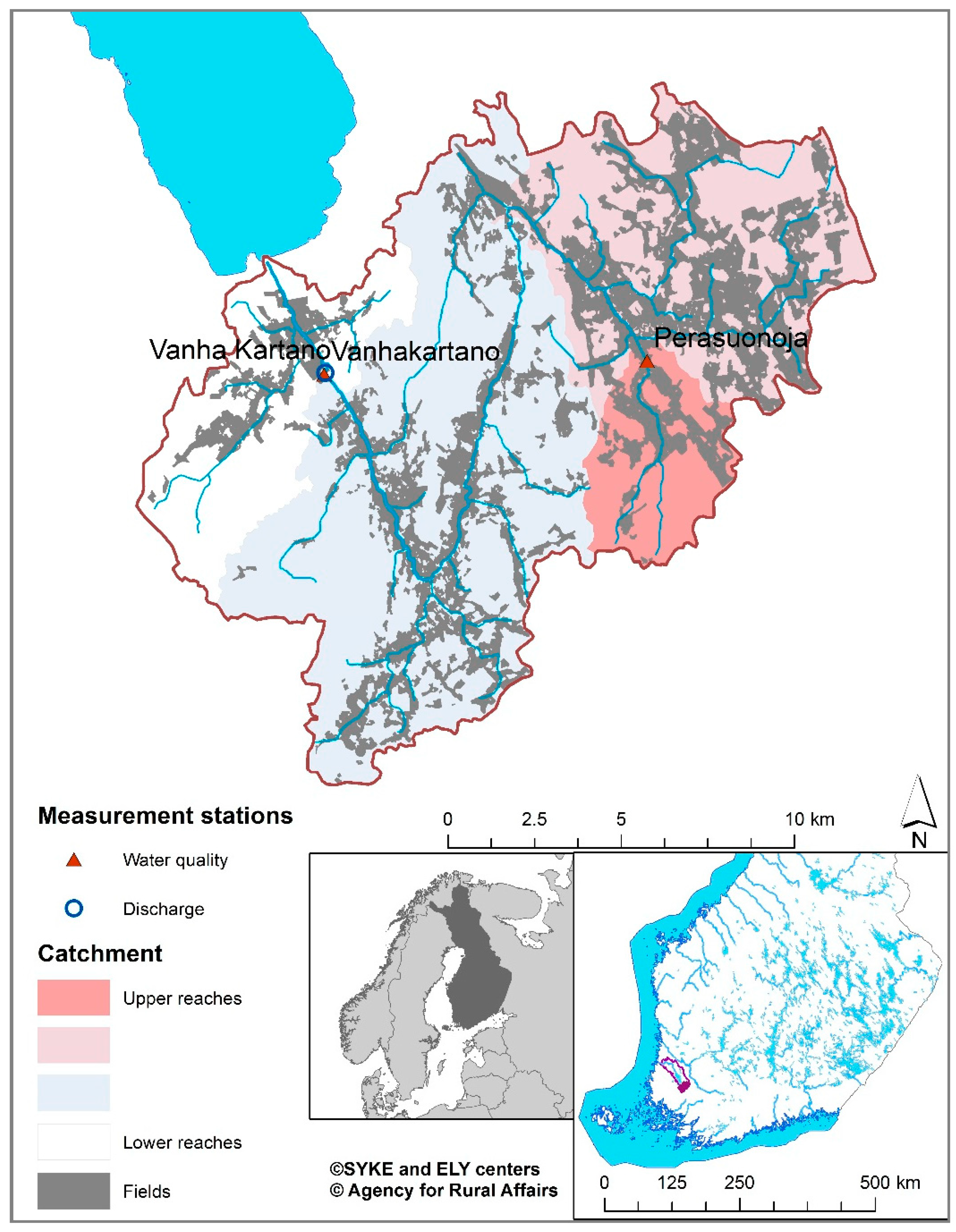
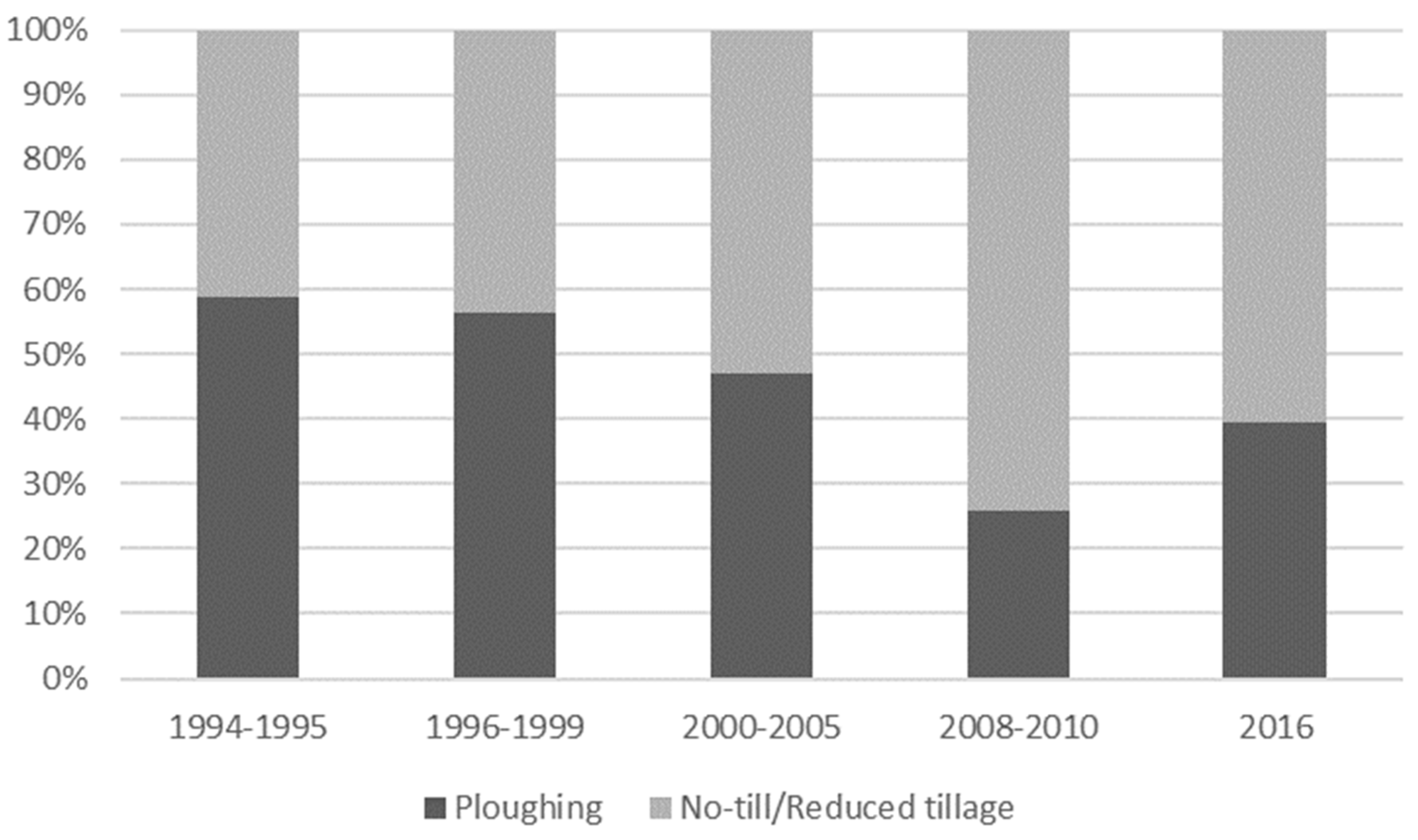


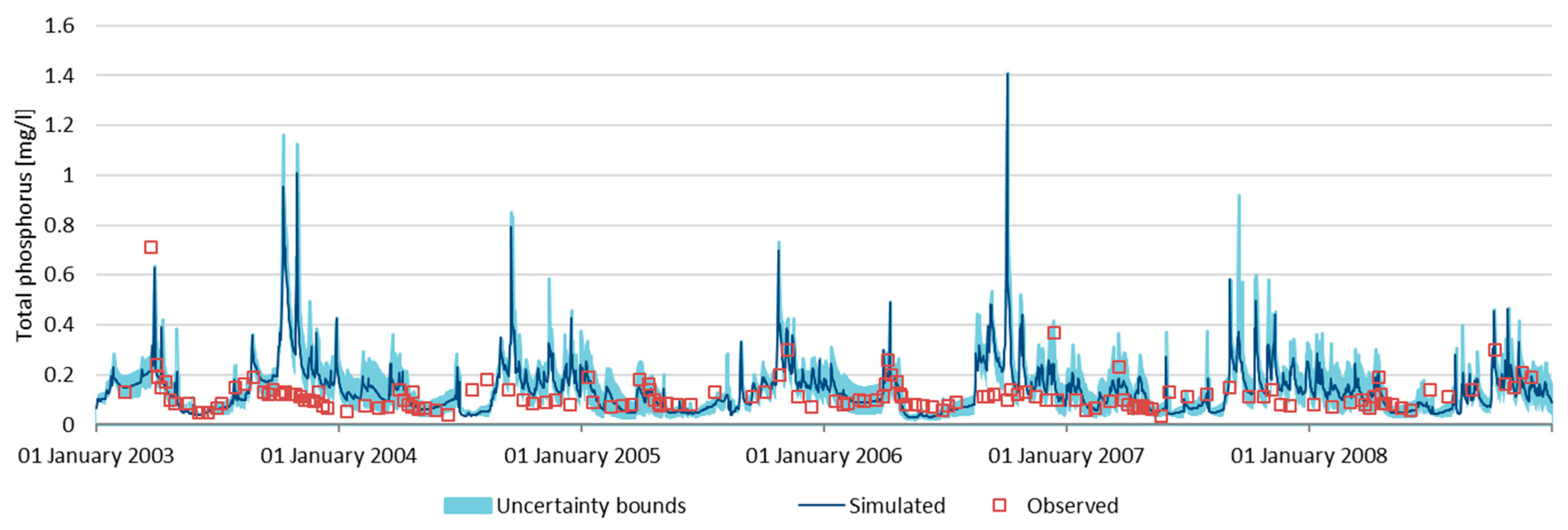
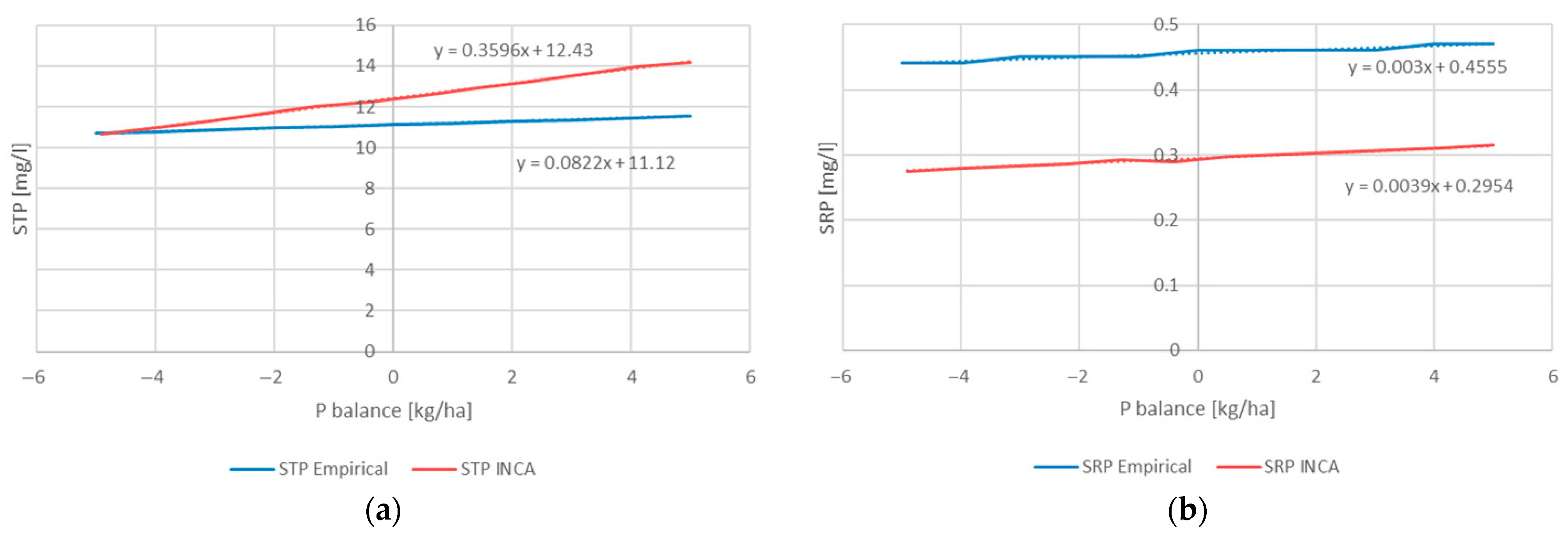


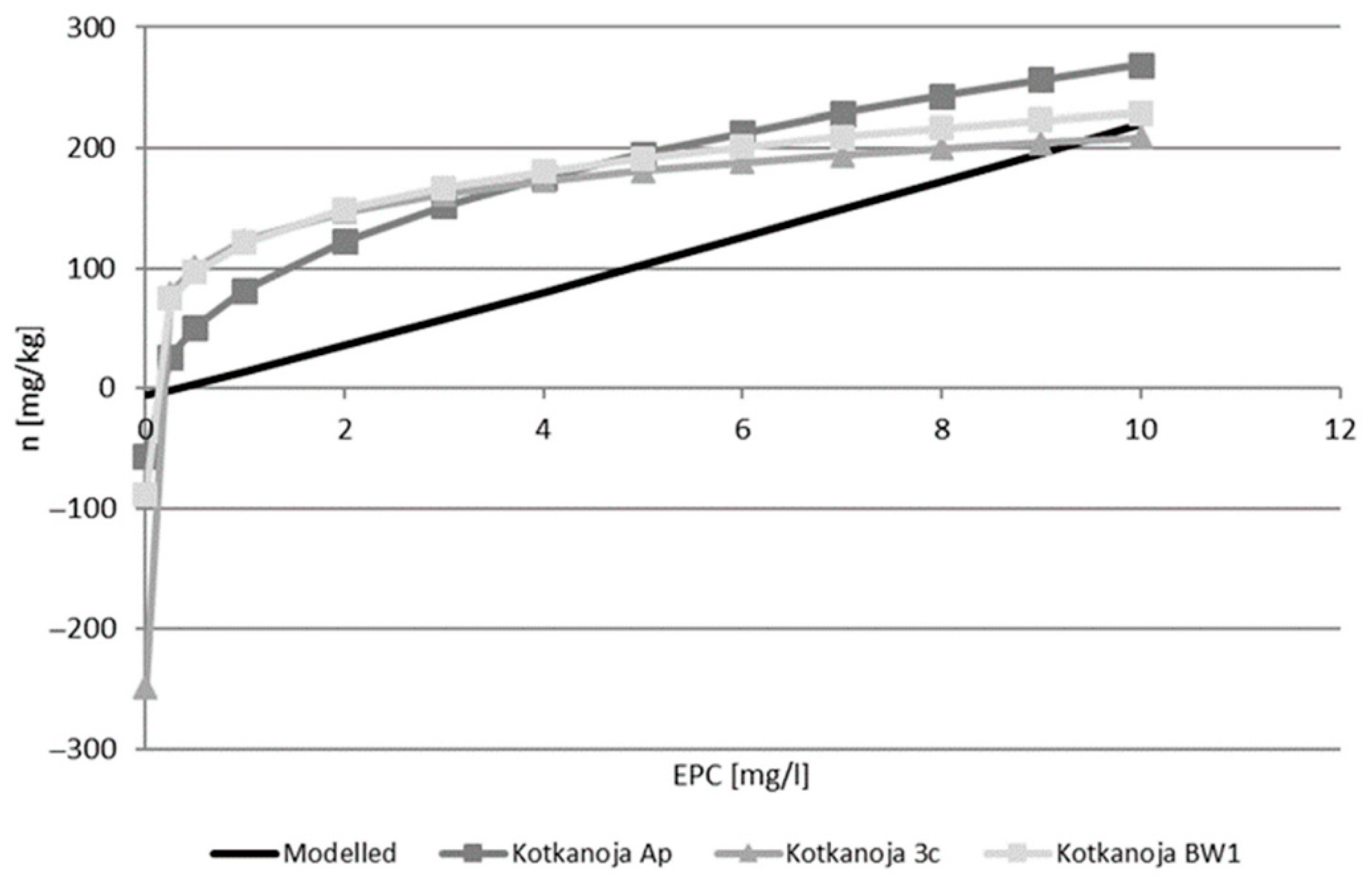
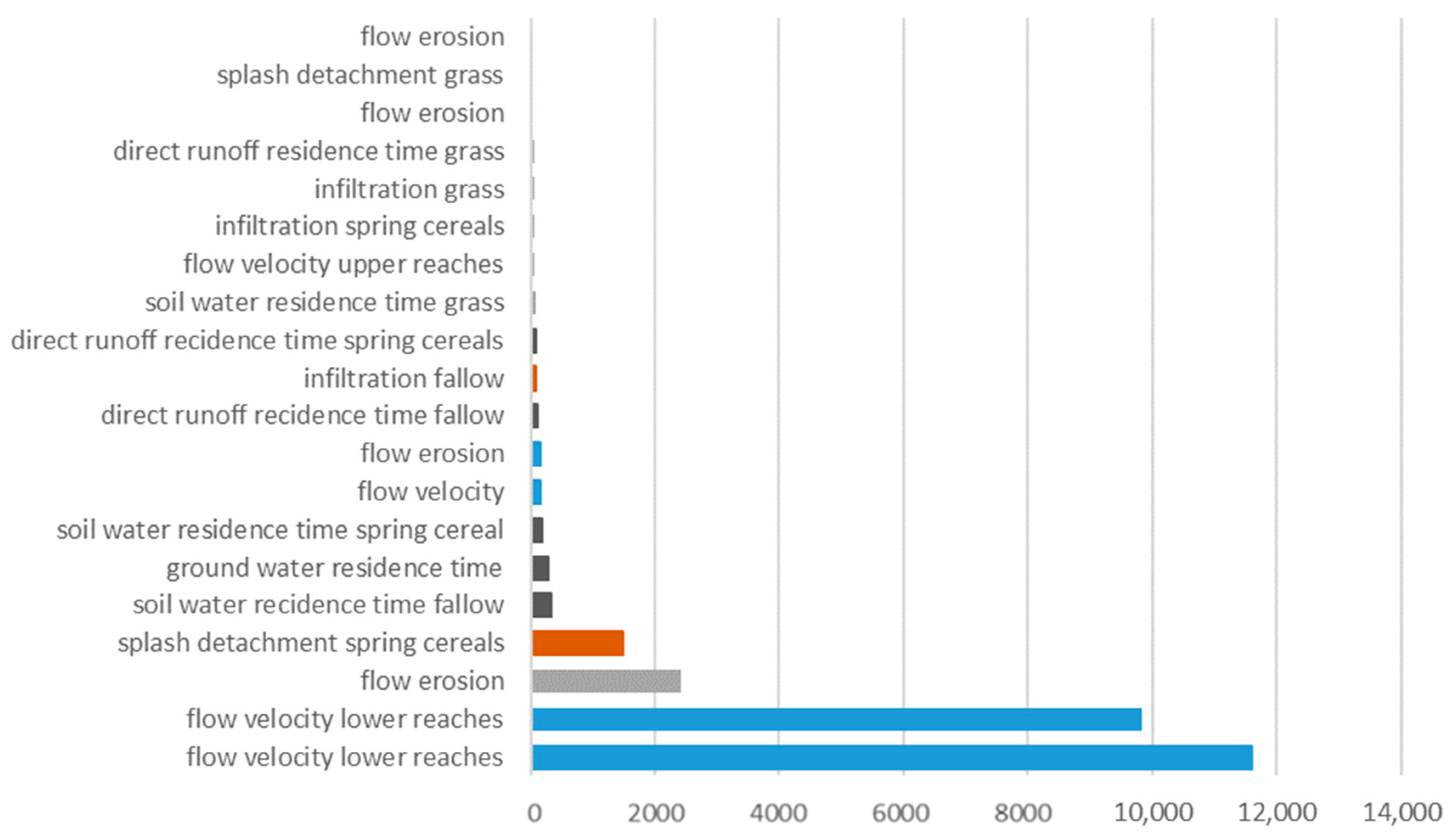
| Station | Calibration | Validation | |||||||
|---|---|---|---|---|---|---|---|---|---|
| R2 | NSE | RMSE | PBIAS | R2 | NSE | RMSE | PBIAS | ||
| Automatic station | Q | 0.623 | 0.456 | 78.769 | 51.33 | - | - | - | |
| NO3-N | 0.262 | - | 95.884 | 0.087 | - | - | - | ||
| Vanhakartano | Q | 0.724 | 0.714 | 90.065 | 9.68 | 0.374 | 0.373 | 128.354 | 1.21 |
| TP | 0.167 | - | 71.027 | 25.42 | 0.1 | - | 79.133 | 4.68 | |
| DRP | 0.1 | - | 94.189 | 19.78 | 0.088 | - | 121.116 | 21.71 | |
| NO3-N | 0.351 | - | 71.126 | 0.30 | 0.168 | - | 201.437 | 0.81 | |
| Land Use Period | TP | DRP | SS | NO3-N |
|---|---|---|---|---|
| [%] | [%] | [%] | [%] | |
| 1994–1995 | −4% | 2% | −6% | −4% |
| 2008–2010 | −5% | 10% | −11% | −5% |
| Land Use Class | PP | DRP | SS | NO3−N |
|---|---|---|---|---|
| [kg/ha] | [kg/ha] | [kg/ha] | [kg/ha] | |
| Spring cereals, autumn ploughing | 0.8 | 0.4 | 489.1 | 18.3 |
| Spring cereals, autumn stubble cultivation | 0.6 | 0.5 | 418.0 | 15.2 |
| Spring cereals, no-till | 0.5 | 0.7 | 302.2 | 12.4 |
| Grass | 0.4 | 0.8 | 248.9 | 5.1 |
| Set-aside grass | 0.3 | 0.6 | 207.5 | 4.8 |
Publisher’s Note: MDPI stays neutral with regard to jurisdictional claims in published maps and institutional affiliations. |
© 2021 by the authors. Licensee MDPI, Basel, Switzerland. This article is an open access article distributed under the terms and conditions of the Creative Commons Attribution (CC BY) license (http://creativecommons.org/licenses/by/4.0/).
Share and Cite
Rankinen, K.; Turtola, E.; Lemola, R.; Futter, M.; Cano Bernal, J.E. Nutrient Load Mitigation with Wintertime Cover as Estimated by the INCA Model. Water 2021, 13, 450. https://doi.org/10.3390/w13040450
Rankinen K, Turtola E, Lemola R, Futter M, Cano Bernal JE. Nutrient Load Mitigation with Wintertime Cover as Estimated by the INCA Model. Water. 2021; 13(4):450. https://doi.org/10.3390/w13040450
Chicago/Turabian StyleRankinen, Katri, Eila Turtola, Riitta Lemola, Martyn Futter, and José Enrique Cano Bernal. 2021. "Nutrient Load Mitigation with Wintertime Cover as Estimated by the INCA Model" Water 13, no. 4: 450. https://doi.org/10.3390/w13040450






